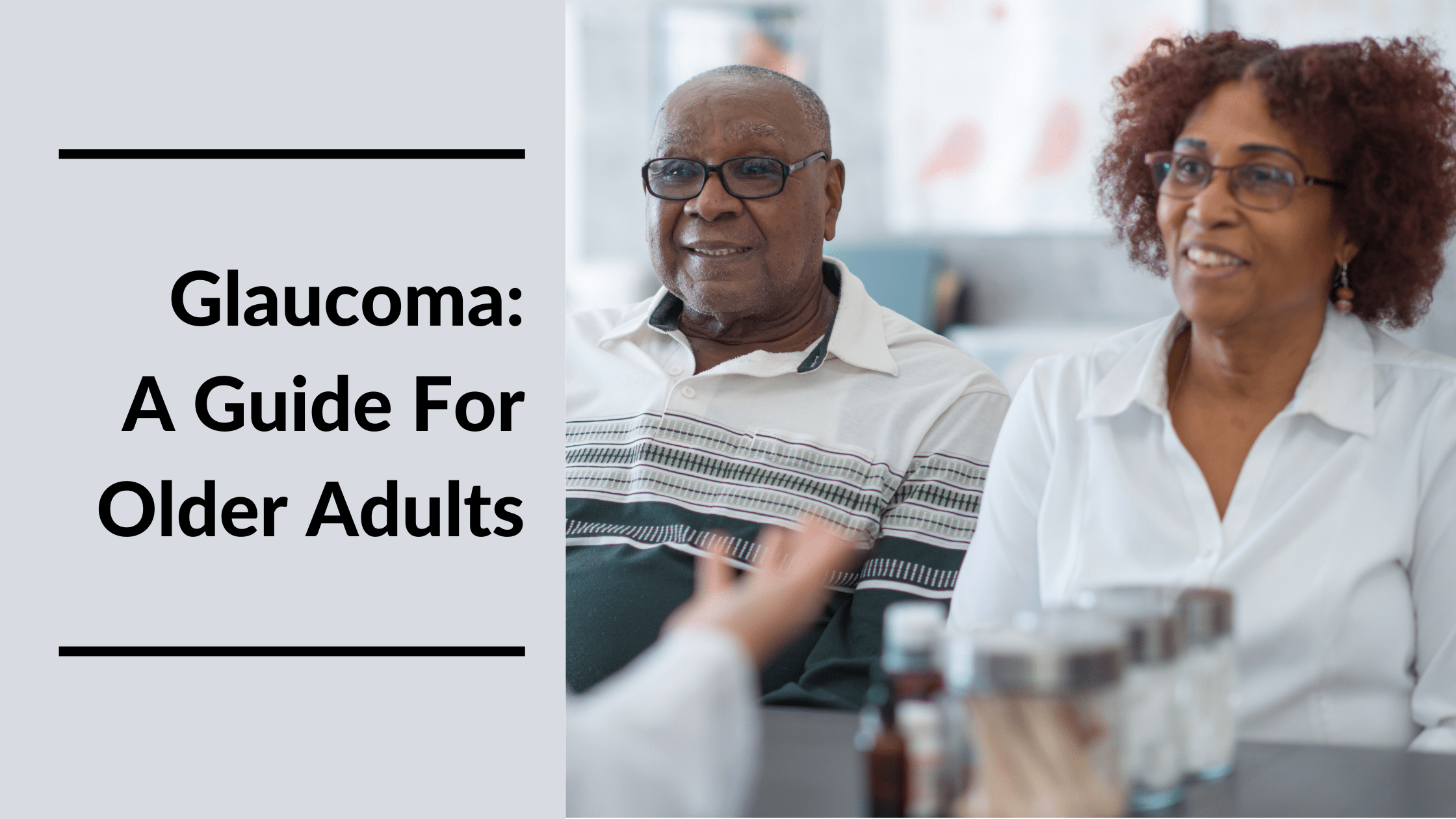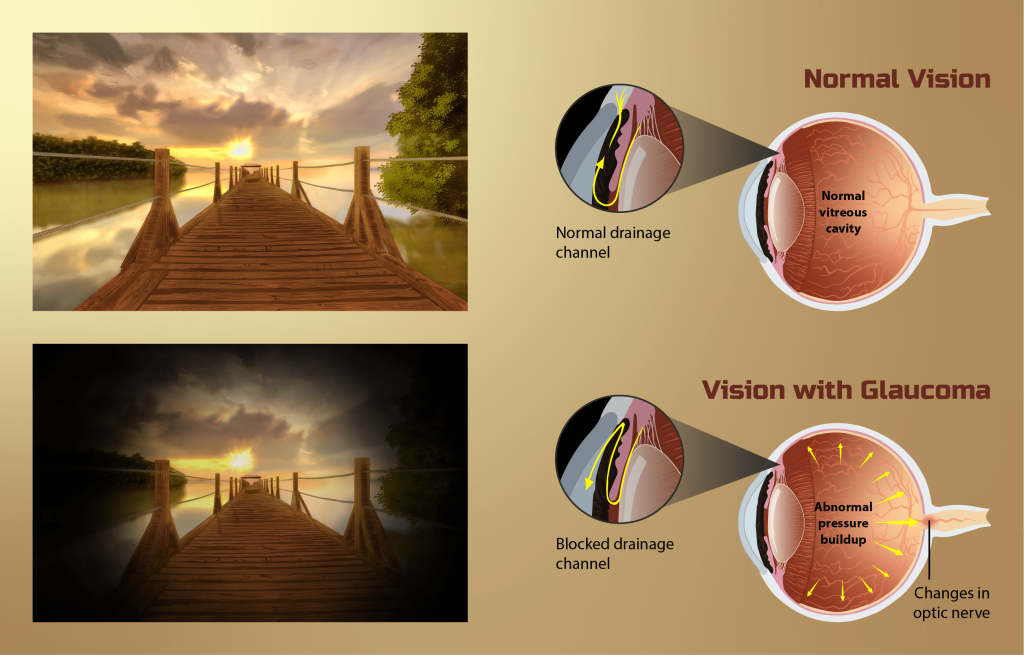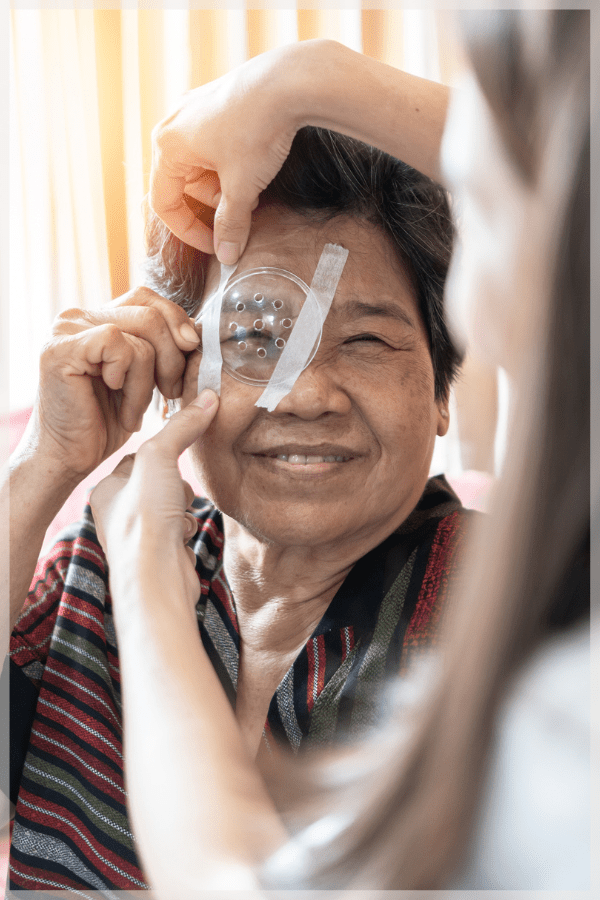
Glaucoma affects seniors more than any other group. Learn more about this disease so you can recognize the signs and get help before it’s too late.
Updated December 9, 2022
What Should Seniors Know About Glaucoma?
Did you know that glaucoma causes 10% of blindness cases in the US? Or that ¾ of people who become legally blind due to this disease are seniors?
This condition affects about 3 million people in the US. It can happen to anyone at any age, though it’s most likely to develop in seniors. Not just that, but according to the Glaucoma Research Foundation, 50% of cases are undiagnosed.
A glaucoma diagnosis doesn’t guarantee eventual vision loss. However, there are many ways to treat glaucoma. If you’re proactive about regular checkups and exams, you can preserve your vision and quality of life.
What Is Glaucoma?
Glaucoma is an overarching term for a collection of conditions that develop when the optic nerve is damaged, impacting the degree of vision.
The optic nerve, located in the rear of the eyeball, is the primary facilitator for sending information from the eye to the brain. This condition causes excess pressure in the eye, harming the optic nerve and stopping it from processing information correctly.
How the pressure grows and the amount in the eye determines which form of the disease is present, but generally, 90% of patients develop open-angle glaucoma.
What Are The Causes Of Glaucoma?
Damage to the optic nerve induced by excess pressure is one of the leading causes of this disease. This swelling occurs when the fluid that moves within the eye cannot drain and make room for new fluid. This buildup can create harmful pressure within the eye. The National Eye Institute explains how excessive fluid damages the optic nerve:
- The fluid flows through the anterior chamber near the front of the eye. The fluid acts like a natural, built-in self-cleaning service for different parts of the eye.
- Once the fluid exits the anterior chamber, it crosses the angle where the cornea and iris meet. This angle is a mesh-like membrane situated in the front of the eye. Since the fluid passes through this membrane, it is considered “open.”
- However, if the flow of the fluid slows and stops moving through the membrane at its earlier pace, it causes the fluid to build, resulting in pressure.
- Occasionally, eyes make too much of this fluid, and it can’t pass through fast enough. Sometimes the membrane gradually becomes blocked over time. Both result in excess pressure that creates glaucoma.
What Are The Symptoms Of Glaucoma?
It can take several years for the pressure to build and become severe enough that glaucoma develops. Unfortunately, by the time the worst symptoms arise, the disease has already had time to progress and possibly cause harm.
During this time, you or your loved one should get help right away to prevent permanent vision loss. However, with regular eye examinations, it may be possible to catch some of the irreversible symptoms, such as:
- Blind spots in your peripheral vision: Your side vision is often the first part of your sight that this disease affects. When blind spots and the eventual absence of peripheral vision happens, it can cause tunnel vision.
- Tunnel vision: It feels like looking through a narrow tube without the ability to see to the side, above, or below.
- Blindness: As the disease progresses, tunnel vision will devolve into blindness.
Blindness may be the main concern for at-risk individuals, but this condition can also cause additional detrimental effects. According to the American Foundation for the Blind, blindness or varying degrees of vision loss can have other consequences, for example:
- Higher fall risks. Low vision can make seniors more likely to miss a step or trip over something in the way. Older adults take longer to recover and are more susceptible to experiencing worse injuries. The consequences of falling become direr as you age.
- Higher rates of depression. Falling and dealing with recovery can significantly contribute to depression in the elderly. Plus, 57% percent of elders with reduced or impaired sight are more likely to experience some degree of depression.
- Difficulty completing daily tasks independently. Vision loss can make it challenging to carry out everyday tasks. Whether it’s bathing, cooking, dressing, and of course, driving, the decreased vision has its toll. When seniors begin struggling, consider a caregiver.
What Are The Types Of Glaucoma?
Some types of this disease can develop more rapidly or even happen under unusual circumstances (such as congenital glaucoma). While 90% of cases are due to open-angle glaucoma, there are other forms that older adults should know. Angle-closure and normal-tension glaucoma make up an additional 10% of diagnoses.
Angle-Closure Glaucoma
The membrane (or angle) where the iris and cornea come together can sometimes be blocked entirely. As a result, the fluid cannot flow through, resulting in accumulation that causes instant, severe pressure.
It can result from an inflamed iris or other exterior eye damage or swiftly-emerging condition. Noticing the signs of angle-closure glaucoma can be challenging because of the disease’s slow progression. Vision loss can happen quickly with this form, so you should immediately seek treatment. In addition, other symptoms include:
- Headaches
- Blurry vision
- Nausea or queasiness
- Tender or sensitive eyes
- Seeing rainbows around lights at nighttime.
Treatment for this type involves surgically removing the blockage to allow the fluid to drain. This process also involves repairing the iris so that fluid movement can resume moving normally.

Normal-Tension Glaucoma
Even people with normal eye pressure levels can develop glaucoma. Often, patients experience no signs or symptoms until it is too late. For this reason, routine screenings and early detection are critical to preventing irreversible damage.
Like angle-closure glaucoma, normal-tension glaucoma can be treated by the same surgical procedure as angle-closure glaucoma. Additionally, eye drops and other medications can help keep eye pressure at a minimum.
What Are The Risk Factors For Glaucoma?
Unfortunately, little is known about normal-tension glaucoma. For example, it’s still unknown why people with normal eye pressure levels can develop this condition.
While there is still a lot to learn about this disease, several factors are shown to increase the risk, including:
- Gender: Women are more likely than men to develop this disease.
- Age: This condition is more likely to occur in those aged 60 and older because of their susceptibility to possible eye damage and other health risks.
- Race: Researchers don’t know why African-Americans and Latinos are more likely to develop this condition. It is also more likely to happen earlier in life than in other races.
- Earlier eye injury: Injury or trauma to the eye that happened years prior can still cause harmful effects.
- Genetics: Family history can increase the chance of developing this disease later in life.
- Cornea thickness: An early 2000s study discovered that people with a thicker cornea are six times as likely to develop this condition.
- Health history: People with blood pressure issues, heart conditions, a history of migraines and prolonged cortisone exposure, Alzheimer’s, thyroid problems, or other eye conditions have a higher risk than those who don’t. Managing blood pressure may lower pressure inside the eye and reduce the risk of this disease.
Testing For Glaucoma
Your doctor can perform several tests to check your eye health and ensure everything is normal. These tests include:
- Tonometry: This test measures pressure levels within the eye and is usually a routine part of every doctor’s appointment. First, the physician administers numbing drops. Next, a machine blows a little air into the eye, gauging its pressure level.
- Gonioscopy: This method tests the distance between the angle where the cornea and iris meet. This test frequently takes place after experiencing some of the signs of the disease and determines which form you may have.
- Ophthalmoscopy: Your doctor may use this test when you have normal pressure but are at risk. By dilating your pupils and using a magnifying tool, they can examine the optic nerve and other parts in the back of the eye.
What Are The Treatment Options For Glaucoma?
Since open-angle glaucoma occurs gradually, it’s possible to catch it early and begin treatment to stop further damage. But, of course, you will only notice it if you visit the eye doctor regularly.
Open-angle and normal-tension glaucoma treatment plans aim to reduce pressure inside the eye. With closed-angle glaucoma, surgery is necessary and typically required immediately. Here are some of the treatment options:
- Medicated eye drops: The benefits of eye drops are that they are affordable and only need administering once a day. However, side effects can include dizziness, asthma attacks, nausea, fatigue, and cardiovascular disease. Despite that, eye drops are one of the most effective ways to lower eye pressure.
- Medication: Prescription medicine reinforces the effectiveness of eye drops. But it often takes several months to work. It is best to use them in conjunction with eye drops, which offer immediate relief.
- Medical marijuana: Medically prescribed marijuana has been an effective treatment for glaucoma for decades. However, it generally only lowers the pressure for up to four hours at a time, and it’s necessary to have 24/7 relief to alleviate symptoms. Often, it is prescribed with eye drops and is good to use for faster relief when the eye drops wear off or you experience their side effects.
Surgery
Except for those with closed-angle glaucoma, surgery is the last option when eye drops, medication, and other measures don’t help. There are two types of surgery to open the angle between the cornea and iris.
- Laser surgery: This non-obtrusive method is fast and pain-free. It can easily unblock the membrane and clear any blockage preventing the normal flow of eye fluid. However, it does have some long-term effects, which are essential to discuss with your doctor.
- Traditional surgery: Traditional surgery involves your doctor physically draining the fluid. This method, while invasive, is beneficial and works long after the surgery.
While surgery can be an advantageous treatment option, it can pose some liability for older adults. Therefore, doctors must appropriately inform patients about the risks.

What Are Some Ways People With Glaucoma Can Find Support?
Routine eye exams are the best way seniors can prevent their condition from worsening. Seniors should aim for once-a-year doctor’s visits. If you have a higher risk of developing this disease, consider going twice. Additionally, eating right and staying active can significantly affect eye health since it lowers the chance of heart disease.
Sadly, glaucoma’s effects on vision are irreversible. But, there are options for those with impaired vision or even blindness. Low vision rehabilitation can help seniors retain their quality of life, even with reduced vision. Through low-vision rehab programs, patients can learn new training and technology to help them manage life with their remaining sight.
Some local organizations or agencies provide information about low vision counseling, training, support groups, or other services. Call the National Senior Information Helpline at 1-800-766-1116 to begin the search for services in your area.
MeetCaregivers Can Help
Any degree of vision loss is devastating. It can contribute to feelings of helplessness, loss of independence, depression, and more. However, it’s possible to continue living a healthy life. Hiring a caregiver can help maintain quality of life and manage well-being.
Don’t let vision loss prevent you from living your best life. Let MeetCaregivers help. Our qualified caregivers can help with transportation, dressing, cooking, and more.
Call 1 (888) 541-1136 or Find A Caregiver today.
Check the Blog for resources and tips for happy, healthy senior living.
- Fingeret, M. (2002, December 1). OHTS: corneal thickness is the newest risk factor for glaucoma. Retrieved from https://tinyurl.com/s9a9cap2
- Gaunt, A. (2022, January 31). Early Glaucoma Symptoms and Treatment. Early Glaucoma Symptoms and Treatment | A Place for Mom. Retrieved from https://tinyurl.com/5n7h7a93
- Glaucoma Research Foundation . (2022, August 5). Five Common Glaucoma Tests. Five Common Glaucoma Tests | glaucoma.org. Retrieved from https://tinyurl.com/mrxvkyzw
- Glaucoma Research Foundation. (2021, April 21). What is Glaucoma? What is Glaucoma? | glaucoma.org. Retrieved from https://tinyurl.com/3ydzucum
- He, Z., Vingrys, A. J., Armitage, J. A., & Bui, B. V. (2011, January 24). The role of blood pressure in glaucoma. The role of blood pressure in glaucoma – Wiley Online Library. Retrieved from https://tinyurl.com/euhcnbh6 doi/full/10.1111/j.1444-0938.2010.00564.x
- National Eye Institute. (2022, April 27). Learn About Eye Health. Learn About Eye Health | National Eye Institute. Retrieved from https://tinyurl.com/5cvvwc49
- Suchy, F. M. (2022, October). Glaucoma: A Guide For Seniors. Glaucoma: A Guide For Seniors – Aging.com. Retrieved from https://tinyurl.com/ejbun9b5
- Urban, Jr., R. C., Graham, L., & Bainter, P. S. (2020, May 25). Normal-Tension Glaucoma. What Is Normal-Tension Glaucoma? Risk, Treatment & Prognosis. Retrieved from https://tinyurl.com/s8hm3z7x
